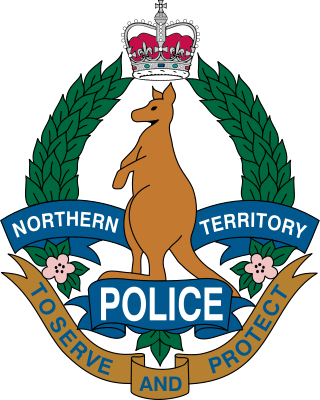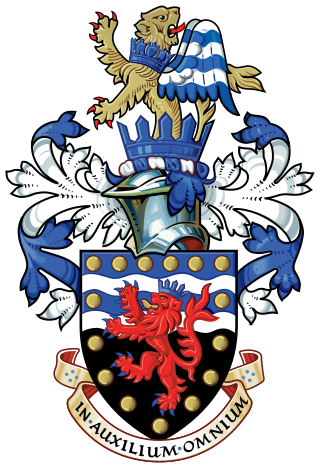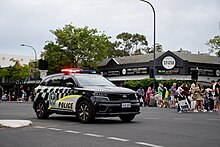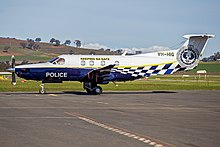
The New South Wales Police Force is a law enforcement agency of the state of New South Wales, Australia, established in 1862. With more than 17,000 police, it is the largest police organisation in Australia, policing an area of 801,600 square kilometres with a population of more than 8.2 million people.
A Police Community Support Officer, or as written in legislation Community Support Officer, is a uniformed member of police staff in England and Wales, a role created by Section 38(2) of the Police Reform Act 2002, which was given Royal Assent by Queen Elizabeth II on 24 July 2002. They are not warranted, but hold a variety of police powers and the power of a constable in various instances by the forty-three territorial police forces in England and Wales and the British Transport Police.

Law enforcement in Australia is one of the three major components of the country's justice system, along with courts and corrections. Law enforcement officers are employed by all three levels of government – federal, state/territory, and local.

Victoria Police is the primary law enforcement agency of the Australian state of Victoria. It was formed in 1853 and currently operates under the Victoria Police Act 2013.

The Queensland Police Service (QPS) is the principal law enforcement agency responsible for policing the Australian state of Queensland. In 1990, the Queensland Police Force was officially renamed the Queensland Police Service and the old motto of "Firmness with Courtesy" was changed to "With Honour We Serve". The headquarters of the Queensland Police Service is located at 200 Roma Street, Brisbane.

The Northern Territory Police Force is the police body that has legal jurisdiction over the Northern Territory of Australia. This police service has 1,607 police members made up of 83 senior sergeants, 228 sergeants, 912 constables, 220 auxiliaries, and 64 Aboriginal Community Police Officers. The rest of the positions are members of commissioned rank and inoperative positions. It also has a civilian staff working across the NT Police, Fire and Emergency Services.

Devon and Cornwall Police is the territorial police force responsible for policing the ceremonial counties of Devon and Cornwall in South West England. The force serves approximately 1.8 million people over an area of 3,967 square miles (10,270 km2).
Inspector, also police inspector or inspector of police, is a police rank. The rank or position varies in seniority depending on the organization that uses it.

The Zimbabwe Republic Police (ZRP) is the national police force of Zimbabwe, having succeeded the British South Africa Police on 1 August 1980.

ACT Policing is the portfolio of the Australian Federal Police (AFP) responsible for providing policing services to the Australian Capital Territory (ACT). The Australian Capital Territory Police was an independent police force responsible for policing the ACT until 19 October 1979, when it was merged with the Commonwealth Police to form the AFP.

Special Tasks and Rescue Group is the Police Tactical Group of the South Australia Police.

The York Regional Police (YRP) is the police service of the Regional Municipality of York, Ontario, Canada. YRP was formed in 1971 from the police forces maintained by the nine municipalities which amalgamated into York Region at the time. The force had a strength of over 1,500 sworn members and 618 unsworn members as of 2015.

The Jamaica Constabulary Force (JCF) is the national police force of Jamaica.

Law enforcement in Ethiopia is dealt with by the Ethiopian Federal Police at federal level and by regional police commissions in the Regions of Ethiopia. The Ethiopian Federal Police (EFP) was established in 1995 to serve the public, to ensure the observation of human and democratic rights and to maintain the safety and welfare of the public. Its stated duties are the enforcement of laws and safeguarding constitutional guarantees, the prevention, detection and investigation of crime, the coordination of national state police commissions and development of national policing standards. The EFP also has to provide operational support to regional police commissions.
However, local militias also provide local security largely independent of the police and the Ethiopian military. Corruption is a perennial problem, particularly among traffic police who solicited bribes.
The U.S. Department of State states that its contacts within the Ethiopian government report that the findings of investigations into abuses by local security forces, such as arbitrary detentions and beatings of civilians, are rarely made public. However, the Ethiopian government continued its efforts to train police and army recruits in human rights. During 2008 the government was seeking assistance from the International Committee of the Red Cross, the local non-governmental organization Prison Fellowship Ethiopia (JFA-PFE), and the Ethiopian Human Rights Commission to improve and professionalize its human rights training and curriculum. The JFA-PFE provided human rights training for police commissioners and members of the militia in 2008.

Sri Lanka Police is the civilian national police force of the Democratic Socialist Republic of Sri Lanka. The police force is responsible for enforcing criminal and traffic law, enhancing public safety, maintaining order and keeping the peace throughout Sri Lanka. The police force consists of 43 Territorial Divisions, 67 Functional Divisions, 432 Police Stations with more than 84,000 people. The professional head of the police is the Inspector General of Police who reports to the Minister of Law and Order as well as the National Police Commission. The current Inspector General of Police (Acting) is Deshabandu Tennakoon.

The history of the Queensland Police Service in Queensland, Australia, commenced in 1864, five years after the Separation of Queensland from New South Wales in 1859. This timeline highlights significant developments in Queensland policing.
The Hong Kong Police Force (HKPF) is structured into numerous bureaus and units. As a whole, it is commanded by the Commissioner of Police, who is assisted by three deputy commissioners. The "Deputy Commissioner – Operations" supervises all operational matters including crime. The "Deputy Commissioner – Management" is responsible for the direction and co-ordination of force management including personnel, training, and management services. The “Deputy Commissioner — National Security” is responsible for the National Security Department, which deals with acts of sedition, terrorism, and collusion with foreign governments.
The police in Canada's ranks differ according to the different police forces and depend on different laws at the federal, provincial, and municipal levels.

The Security Response Section (SRS) is a unit of the South Australia Police, deployed to “at-risk” crowded places such as large protests and AFL games, and to conduct regular patrols of Rundle Mall, the Adelaide Railway Station and the Adelaide Central Market. The SRS is a second-tier response between general duties and Special Tasks and Rescue. Unlike regular police officers, the unit has enhanced tactical skills and operational equipment including combat helmets, ballistic vests and long-arm weapons such as semi-automatic rifles. The unit is claimed to “significantly bolster public safety”.


















































